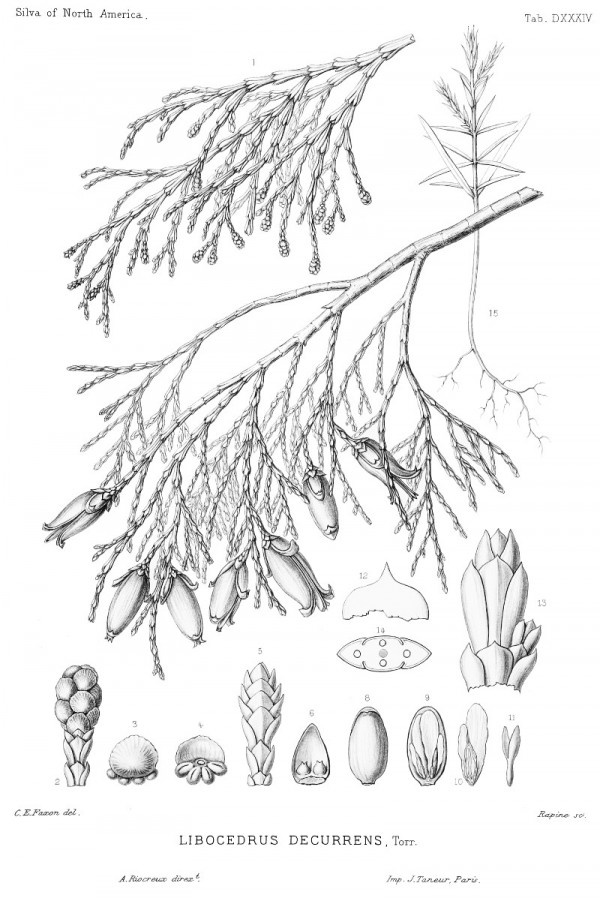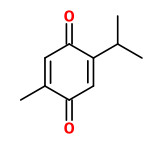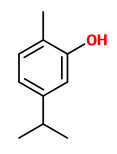Calocedrus decurrens (Torr.) Florin - syn.Libocedrus decurrens Torr. - Cupressaceae
(California) incense cedar, (Kalifornische) Weihrauchzeder
Evergreen tree, up to 50m tall, native to North America (Oregon, Nevada, California, Baja California); bark cinnamon brown, fibrous, furrowed and ridged; leaves up to 14mm long; pollen cones red-brown to light brown; seed cones oblong-ovate when closed, red-brown to golden brown, proximal scales often reflexed at cone maturity.
„Incense-cedar is an important commercial softwood species. Its wood, exceptionally resistant to decay and highly durable when exposed to weather, is manufactured into many products, including lumber, pencil stock (for which it is the major United States source), fence posts, shakes, and landscape timbers, which are attractive because of punky spots resulting from fungus. The tree is widely grown as a handsome ornamental.“
http://www.efloras.org/florataxon.aspx?flora_id=1&taxon_id=233500299
„The foliage, when crushed, gives off an aroma somewhat akin to shoe-polish.“ https://en.wikipedia.org/wiki/Calocedrus_decurrens
„Incense-cedar also is used extensively for exterior siding because it is dimensionally stable and holds paint well, in addition to being durable. Rich color, sound knots, and aromatic fragrance make the wood popular for interior paneling and woodwork… Incense-cedar is ideally suited to the manufacture of pencils because it is soft, easily whittled, and has straight grain. Much of the top-grade lumber produced goes to this use.“ [U.S. Forest Service Silvics Manual] http://www.na.fs.fed.us/pubs/silvics_manual/Volume_1/libocedrus/decurrens.htm
Main components of the volatile oil of the leaves were δ-3-carene (15.2-20.2%), limonene (18.2-23.6%), α-pinene (8.7-15.8%), terpinolene (5.7-8.0%) and α-fenchyl acetate (3.5-9.7%) with some cedrol (0.8-1.2%).
[The leaf essential oils of the genus Calocedrus., Adams, R.P., Nguyen, S., Hsieh, C.F., Kaiyun, G., Journal of Essential Oil Research, 18(6), 2006, 654-658]
(3E,5Z)-undecatriene (0.3%) was a key odorant in headspace samples of Calocedrus decurrens leaves.
[Scent of a vanishing flora, Roman Kaiser, 2011, 170]
Steam distillation of C.decurrens heartwood gave 0.6% of an essential oil composed mainly of derivatives of p-cymene and p-menthane. Thymoquinone (35.9%), carvacrol (29.2%), p-methoxythymol (11.0%) and p-methoxycarvacrol (3.2%) were the main components. „The tropolone beta-thujaplicin (hinokitiol) was only present in trace amounts. The high concentrations of thymoquinone and carvacrol alone can account for the previously observed high bioactivity of this oil. Carvacrol is well known for its antimicrobial, antioxidant, insecticidal, and repellent activities.“
[Composition of the heartwood essential oil of incense cedar (Calocedrus decurrens Torr.)., Veluthoor, S., Kelsey, R.G., González-Hernández, M.P., Panella, N., Dolan, M., Karchesy, J., Holzforschung, 65(3), 2011, 333-336] http://www.fs.fed.us/pnw/pubs/journals/pnw_2011_veluthoor.pdf
„Among the main odorants [of the wood from C.decurrens] found were a series of terpenes, several degradation products of fatty acids, and a number of odorants with a phenolic core moiety. Five odorants are reported here for the first time as wood odorants, such as γ-octalactone and 3-phenylpropanoic acid; thymoquinone was demonstrated for the first time to have a pencil-like odor quality.“
AEDA showed the 22 potent odorants, the most potent (FD factor 81-729) were (FD factor; odor quality):
α-pinene (729; woody resinous), acetic acid (243, vinegar-like), (Z)-non-2-enal (243; fatty), (E)-non-2-enal (243; fatty), fenchol (729; moldy), butanoic acid (81; cheesy), 3-methylbutanoic acid (729; cheesy), (E,E)-nona-2,4-dienal (729; fatty), (E,E)-deca-2,4-dienal (81; fatty), β-damascenone (81; apple juice-like), hexanoic acid (81; sweet musty metallic), γ-octalactone (243; sweet coconut-like), p-cresol (729; horse-like), sotolone (729; spicy savory), α-bisabolol (729; pepper-like), phenylacetic acid (243; honey-like), vanillin (729; vanilla), 3-phenylpropanoic acid (729; fruity sweet metallic), unknown (sweaty perfume-like, androstenone-like), unknown-tentavely thunbergol (729; gingerbread-like), thymoquinone (243; pencil-like).
[Schreiner, Linda, Helene M. Loos, and Andrea Buettner. „Identification of odorants in wood of Calocedrus decurrens (Torr.) Florin by aroma extract dilution analysis and two-dimensional gas chromatography-mass spectrometry/olfactometry.“ Analytical and bioanalytical chemistry 409.15 (2017): 3719-3729]
Using stable isotope dilution analysis (SIDA) and odor activity values (OAVs) calculated on the basis of odor thresholds determined in cellulose, hexanal, octanal, (E)-non-2-enal, p-cresol, vanillin, and thymoquinone were the dominant odorants for wood odor of several softwood species (Pinus sylvestris, Larix decidua, Calocedrus decurrens, Abies concolor, and Picea abies). Incense cedar wood with the mainly pencil-like,
eucalyptus-like odor was rated different from pine, larch, and spruce odor. The odor impression vinegar-like, which is characteristic for acetic acid, was rated as the most intense in the incense cedar.
„Regarding the quantitative results of thymoquinone, it is striking that its content was higher in the incense cedar wood at the same time being the only sample exceeding the odor threshold in cellulose (OAV = 4). This finding stands in line with the strong pencil-like odor perceived during the sensory evaluation. The odorant occurs in a 2500 times higher concentration in the incense cedar (1.1 g/kg) compared to the next
highest value of 416 μg/kg in the Scots pine sample.“
[Schreiner, Linda, Eva Ortner, and Andrea Buettner. „Nosy confirmation: reconstitution of the characteristic odor of softwood via quantitative analysis and human sensory evaluation.“ Analytical and Bioanalytical Chemistry (2019): 1-13]

Sargent,C.S., The Silva of North America, vol.10 t.534 (1898) [C.E. Faxon]
http://plantgenera.org/species.php?id_species=181238
Calocedrus decurrens, Schlosspark Schönbrunn
© Rolf Marschner (2006),
www.botanische-spaziergaenge.at





